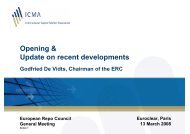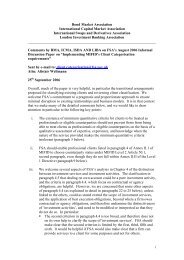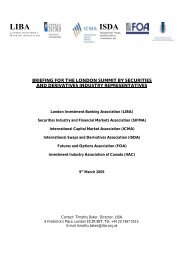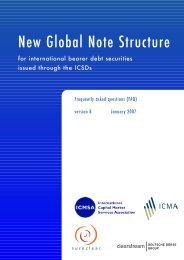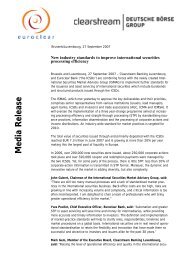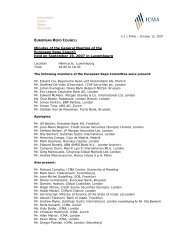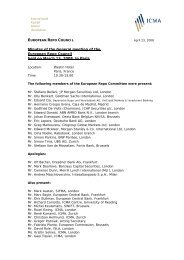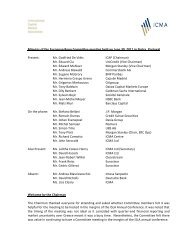Issue no. 22: ICMA Regulatory Policy Newsletter
Issue no. 22: ICMA Regulatory Policy Newsletter
Issue no. 22: ICMA Regulatory Policy Newsletter
Create successful ePaper yourself
Turn your PDF publications into a flip-book with our unique Google optimized e-Paper software.
Market structure<br />
<strong>ICMA</strong> was asked to contribute to the work of a Study Group<br />
to revitalise the corporate bond markets in Japan. <strong>ICMA</strong> made<br />
a short presentation chiefly in relation to market structure and<br />
regulation, which was well received. The main points of the<br />
presentation are summarised here:<br />
First, a market can<strong>no</strong>t exist without demand and supply.<br />
Supply comes from issuers, for whom a bond issue represents<br />
an attractive alternative to bank borrowing or equity finance<br />
(new issue or retained profits). Before 2008, it was fashionable<br />
in the West to retire equity (share buybacks) in favour of<br />
debt; this made corporate and bank balance sheets more<br />
fragile when the downturn came. Demand comes primarily<br />
from insurance companies and pension funds; these are<br />
typically “buy and hold” investors. A second group are retail<br />
investors, either directly or through bond funds. Shorter-term<br />
operators include hedge funds and – if markets are sufficiently<br />
automated and transparent – high frequency and algorithmic<br />
traders. Corporate treasurers (including bank treasurers) are<br />
a<strong>no</strong>ther important group, including those involved in shortterm<br />
secured operations (repo). Design of market structure<br />
must take account of the needs of all these groups.<br />
Second, assuming the questions raised above can be<br />
answered satisfactorily, is the question of market structure.<br />
The broad choice is between a dealer market and an auction<br />
market; generally, bond markets are suited to the dealer model,<br />
though moves are underway in Europe (particularly France) to<br />
test whether continuous auction markets have a role to play.<br />
Early indications suggest a degree of scepticism, though this is<br />
usual at the early stages of an in<strong>no</strong>vation to market structure.<br />
Dealer markets require dealers willing to commit capital; and<br />
this will be a function of the commercial opportunities offered by<br />
the market. Bond market transparency is a hot topic in Europe<br />
at the moment. It is important that the transparency regime<br />
is designed to optimise two aspects: investor confidence<br />
(that they can deal at, or close to, advertised prices and that<br />
sufficient aggregated information about completed trades is<br />
available) and dealer protection (that dealers have sufficient<br />
opportunity to re-balance their books without adverse price<br />
Future of bond trading<br />
<strong>ICMA</strong>’s Secondary Market Practices Committee, a body<br />
composed of a representative selection of <strong>ICMA</strong> member<br />
firms with a significant presence in the secondary debt<br />
markets, recently considered a paper on the long term<br />
future of secondary bond market trading in Europe. This<br />
SECONDARY MARKETS<br />
movements as a result of early publication of a trade). Dealers<br />
are usually banks or specialised security dealers; to finance<br />
their inventory, dealers make extensive use of repo.<br />
Third, robust post-trading arrangements are crucial. Central<br />
clearing is <strong>no</strong>t widespread; it has been proposed by one of the<br />
experimental offerings referred to above, but it adds cost and<br />
operational complexity, in return for some additional security.<br />
Central clearing is also used in the repo market, particularly for<br />
term repo. Settlement must be cheap and efficient; these criteria<br />
are most likely to be met by a settlement house which can<br />
enjoy eco<strong>no</strong>mies of scale and scope because it settles other<br />
securities. Safety and soundness of post trading arrangements<br />
are also essential and these are generally assured by licensing<br />
and oversight by the public authorities. Settlement houses<br />
must also comply with international standards (CPSS-IOSCO)<br />
and accounting and process control standards. Settlement<br />
between banks must be in central bank money.<br />
Fourth, macroprudential regulation: the bond market is an<br />
important source of financing and a transmission mechanism<br />
for shocks; the authorities will therefore take a close interest<br />
in its structure, safety and soundness, robustness, and in its<br />
daily operations. Bond prices send important signals about<br />
investors’ views of the prospects for the eco<strong>no</strong>my and the<br />
likely future course of interest rates (yield curve).<br />
Finally, microprudential regulation, conduct of business and<br />
investor protection all have a role to play. In addition to<br />
prudential supervision at the level of the firm, the authorities<br />
should seek to ensure that the bond markets are protected from<br />
abuse (price manipulation, abuse of unpublished information)<br />
and that market participants adhere to standards of business<br />
behaviour. In relation to investor protection it will be important<br />
to ensure that existing investor protection standards in relation<br />
to securities are applied and that due account is taken of the<br />
special characteristics of bonds (predictability of cash flows,<br />
probability of default) so that appropriately high standards do<br />
<strong>no</strong>t unnecessarily restrict the development of a successful,<br />
deep and liquid bond market.<br />
identified a number of emerging trends which would put<br />
current business models under pressure, together with some<br />
ways in which market participants might respond.<br />
First, the paper makes some fundamental assumptions about<br />
the conditions for the market’s continued existence, namely:<br />
that corporates and banks will continue to see value in the<br />
financing opportunities offered by bonds; that investors<br />
will continue to follow mandates and strategies which can<br />
<strong>ICMA</strong> <strong>Regulatory</strong> <strong>Policy</strong> <strong>Newsletter</strong> Third Quarter 2011 | 26




